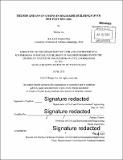Trends and innovations in high-rise buildings over the past decade
Author(s)
Gu, Wenjia, M. Eng. Massachusetts Institute of Technology
DownloadFull printable version (5.845Mb)
Other Contributors
Massachusetts Institute of Technology. Department of Civil and Environmental Engineering.
Advisor
Jerome Connor.
Terms of use
Metadata
Show full item recordAbstract
Over the past decade, high-rise buildings in the world are both booming in quantity and expanding in height. One of the most important reasons driven the achievement is the continuously evolvement of structural systems. In this paper, previous classifications of structural systems are summarized and different types of structural systems are introduced. Besides the structural systems, innovations in other aspects of today's design of high-rise buildings including damping systems, construction techniques, elevator systems as well as sustainability are presented and discussed. To better understand current high-rise buildings, information about buildings above 200 meter completed within recent ten years and the current 100 tallest building in the world is collected and analyzed. Structural systems of worldwide 100 tallest buildings are discussed, from which trends are found. Data shows that tubular systems are in vast majority in recent high-rise building designs and an increasing number of buildings are using concrete and composite materials instead of steel. Developments in structural systems also reduce structures' dependence on auxiliary damping devices. Additionally, sustainability has been given more and more consideration.
Description
Thesis: M. Eng., Massachusetts Institute of Technology, Department of Civil and Environmental Engineering, 2015. Cataloged from PDF version of thesis. Includes bibliographical references (pages 48-49).
Date issued
2015Department
Massachusetts Institute of Technology. Department of Civil and Environmental EngineeringPublisher
Massachusetts Institute of Technology
Keywords
Civil and Environmental Engineering.